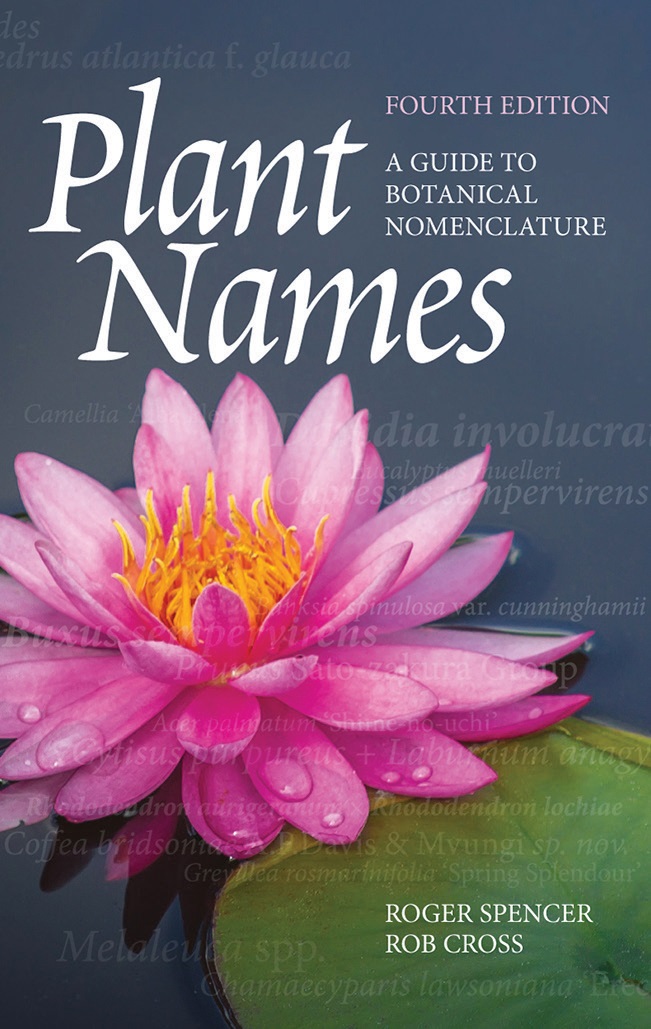Book Review: Plant Names. A Guide to Botanical Nomenclature. 4th Edition

Book Review by Glenn Leiper
‘Plant Names. A Guide to Botanical Nomenclature. Fourth Edition’ by Roger Spence and Rob Cross
Published by CSIRO Publishing, 168 pages
Recommended retail price $44.99
This updated edition incorporates the latest information and changes in the International Code of Nomenclature (ICN) that guides botanists, horticulturists and publishers on accepted technical information such as plant names, naming procedures, cultivar and hybrid naming, plant breeder’s rights and other related issues.

It’s a book that provides much detail but at the same time provides general interest with its explanation of often discussed botanical topics involving plant names and is enhanced with interesting examples and anecdotes. I particularly found interesting the chapters ‘Name Changes’ and ‘Using Plant Names’. This latter chapter clearly (and helpfully) explains the conventions for writing scientific names. It details the use of capitals, abbreviations, italics, latin derivations, spelling and a simple clear explanation of pronunciations.
There’s also a short chapter promoting clear plant labelling for horticulturists, which outlines recommended guidelines for creating an appropriate plant label incorporating the cultivar name as well as the actual scientific name.
A great idea!
Some interesting facts from the book –
• The naming of plants is independent of the naming of animals. An example of the confusion that can arise because of this is the genus Morus. In plants, this is the common Mulberry, Morus nigra. However, there is also a Morus in the animal world – the bird Australian Gannet, Morus serrator.
• With regard to plant names, the ‘Principle of Priority’ applies, which means the first published name of the plant receives priority and becomes the accepted name. This explains why some plants’ scientific names are changed by botanists after some research through old publications, which often causes confusion amongst hobbyists, horticulturists and nurseries (and sometimes amongst “us oldies”).
An example is provided of the ancient and rare Maidenhair Tree Ginkgo biloba named originally by Linnaeus. A British botanical authority in 1797 took a dislike to the “uncouth” scientific name and decided he preferred the sound of Salisburia adiantifolia more and it became a widely used name for the plant in horticulture. However, the Principle of Priority dictated that the original name Ginkgo biloba to be reinstated.
For readers wanting further detail on particular topics, there’s a very useful chapter listing books and websites. After looking at the book initially as a text of little interest to me, I found it surprisingly engaging and informative; and I’ve actually learned quite a few things from it, which is always a good thing!
For those interested in plant naming conventions and the topics mentioned above, I’d recommend this book as a useful and current reference.
CONTENTS
Acknowledgements
Preface
Introduction
Codes of plant nomenclature
Part 1 – Wild plants
Common names
Latin names, the binomial system and plant
classification
The International Code of Nomenclature for Algae,
Fungi, and Plants (ICN)
The botanical hierarchy
Name changes
Part 2 – Cultivated plants and cultigens
The International Code of Nomenclature
for Cultivated Plants
Marketing names (trade designations)
Part 3 – Using plant names
Writing plant names
Pronunciation
Remembering names
Recommended format for nursery plant labels
Part 4 – Plant name resources
Books and websites to help with plant names
Appendix
Glossary and abbreviations
References
Index
Book Review Published: Journal June 2020
